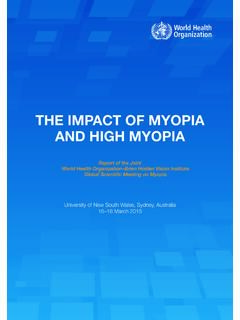Transcription of Virtual Network: Investigating the Risk of COVID-19 ...
1 1 Virtual Network: Investigating the Risk of COVID-19 -Associated Outcomes and COVID-19 Vaccine Effectiveness Using Integrated Medical and Public Health Records (VISION-COVID) Centers for Disease Control and Prevention & Westat DRAFT vs : 6/9/2021 2 Study Summary Title of Study Investigating the Risk of COVID-19 -Associated Outcomes and COVID-19 Vaccine Effectiveness Using Integrated Medical and Public Health Records Investigators Centers for Disease Control and Prevention Catherine Bozio Mark Thompson Eduardo Azziz-Baumgartner Lenee Blanton Sue Reynolds Jill Ferdinands Zijing Guo Palak Patel Eric Griggs Carrie Reed Alicia Fry Westat Sarah Ball Patricia Shifflett Rebecca Birch Rebecca Fink Saloni Sapru 3 Beth Mittl Keith Umbel Sarah Bevan Carly Hallowell Matthew Levy Maria Demarco Participating sites HealthPartners Institute Kaiser Permanente Northwest Universities of California at Irvine, Los Angeles, San Diego.
2 San Francisco and Davis University of Colorado, Denver Atrium Health Intermountain Healthcare Regenstrief Institute Columbia University Baylor, Scott and White Health Protocol Objective We aim to develop a multi-site collaboration to utilize electronic medical and public health records to address key questions about the clinical epidemiology of COVID-19 and COVID-19 vaccine effectiveness. Specifically, we will integrate additional sites (specifically, Atrium Healthcare, Intermountain Healthcare, Regenstrief Institute, Columbia University, and Baylor Scott and White Health) into an existing Virtual network of 4 healthcare systems that follows an IRB-approved protocol. Through this collaboration of healthcare systems and research organizations, the primary aim is to estimate the effectiveness of COVID-19 vaccination in preventing laboratory-confirmed COVID-19 associated health and medical utilization outcomes as well as the incidence of COVID-19 associated outcomes by socio-demographic and high-risk groups.
3 Similar objectives will be accomplished for influenza virus disease and vaccination during periods of local influenza circulation. Deidentified individual-level data will be extracted from medical, laboratory, and vaccination records from each site and defined using a common codebook to accomplish these objectives. Scientific Background Burden of SARS-CoV-2 SARS-CoV-2 continues to be of broad global public health importance and concern due to the global burden of COVID-19 illness and other associated medical complications and severe outcomes identified to date, since the initial identification of the virus in Wuhan, China in December 2019. As of November 23, 2020 in the United States, SARS-CoV-2 infections have resulted in more than million cases of COVID-19 , with a current overall cumulative COVID-19 hospitalization rate of per 100,000, and more than 255,000 Early evidence points to significant burden of severe illness related to SARS-CoV-2 infection by race and ethnicity, age, socio-economic status, and underlying health condition Yet, there are numerous knowledge gaps regarding how COVID-19 and especially severe manifestations of disease impact on different socio-demographic and health risk groups.
4 5 Emerging data on race and ethnicity suggest an overrepresentation of non-Hispanic black patients among those hospitalized for A study using integrated electronic health records identified adults with suspected and confirmed COVID-19 found that compared with non-Hispanic white patients, black patients had times the odds of hospitalization, after adjusting for age, sex, comorbidities, and While all people are susceptible to infection with this novel virus, older adults have elevated rates of COVID-19 -associated hospitalization and the majority of persons hospitalized with COVID-19 have underlying medical In contrast to influenza disease which can be severe in both young children and older adults6, this has not been true with COVID-19 . Population data from China and Italy indicate that children are mildly affected in comparison to adults, representing approximately 5% of cases and less than 1% of admissions to A report describing the burden of COVID-19 infection in North American pediatric intensive care units confirmed that severe COVID-19 can occur in children, though this occurs far less frequently than among COVID-19 has also notably resulted in severe and life-threatening disease among working-age adults and those without prior underlying medical conditions.
5 Further information is needed on the different manifestations or phenotypes of severe COVID-19 across age, health, and other risk groups. Burden of other respiratory viruses and COVID-19 Respiratory viruses, including influenza and respiratory syncytial virus (RSV) among others commonly circulate in the United States during a typical influenza season. However, the incidence of other respiratory viruses during the 2020-21 influenza season and our ability to conduct surveillance may be impacted by COVID-19 in multiple ways. The circulation of 6 seasonal influenza viruses may be reduced as a result of altered health behaviors ( , wearing masks, washing hands) and social distancing measures in response to COVID-19 . For example, a quasi-experimental study assessing the trends in seasonal influenza cases from the 2014-2015 season to the 2019-2020 season in 11 countries and regions, found that in East Asia, the number of seasonal influenza cases in the 2019-20 season was lower after the onset of COVID-19 transmission compared to previous years.
6 9 Influenza testing practices may also change; indeed, influenza testing across the was higher than normal during April 2020 because of the COVID-19 Consequently, data collection on co-circulating respiratory viruses with SARS-CoV-2, especially with respect to testing, care-seeking behavior, and vaccination, will provide important context in interpreting COVID-19 results. Clinical Features of Severe COVID-19 Although medically attended COVID-19 typically manifests as an acute respiratory disease, SARS-CoV-2 infection can also cause a variety of other clinical manifestations, including myocardial dysfunction, acute kidney injury and neurologic More information is needed on the different clinical phenotypes of COVID-19 . Similar to research on severe influenza disease12-16, distinctions can be made between virus disease resulting in acute lung injury and often bacterial superinfection, virus disease associated with extrapulmonary disease, and secondary complications to other organs systems, including neurological impairment.
7 Information is also needed on how these different clinical phenotypes occur within the context of otherwise healthy children and adults versus frail individuals with inadequate physiologic reserve. Most VE studies view hospitalization as the hallmark of severe Yet, the decision to admit a patient is influenced by many factors ( , age, medical history, financial and 7 family resources, clinical decision-making, resource availability) independent from the signs and symptoms of disease. Therefore, more information is needed to differentiate between the clinical severity COVID-19 versus other host and environment factors (such as the local attack rate and population susceptibility) that may be associated with the clinical threshold for hospital admission and discharge and how this may vary between hospitals, medical systems, and regions.
8 COVID-19 Vaccine Effectiveness Although results on the immunogenicity of COVID-19 vaccines from Phase II trials18-19 and early reports on the clinical effectiveness of the vaccines from Phase III trials are encouraging, there will soon be an urgent need for data on the field performance of these vaccines and their effectiveness in preventing laboratory-confirmed COVID-19 -associated emergency department and urgent care (ED/UC) visits and hospitalizations. Evaluating the real-world performance of COVID-19 vaccines is important for at least five reasons. First, since immune response to vaccines and their subsequent protection against infection and disease often vary by sex, age, underlying health status, and other host factors, the preventive benefit of new vaccines may differ in the general public compared to participants in randomized clinical trial.
9 Second, real-world assessments can examine preventive benefits months following vaccination in contrast to the relatively brief surveillance evaluations in Phase III trials. For example, if immune protection following vaccination wanes over time, the impact of waning on VE against medically attended COVID-19 can only be assessed over an extended period of evaluation. Similarly, real-world assessments will also be needed to determine if VE of new vaccines vary depending on the amount and duration of virus exposure and the extent of personal 8 and community infection control measures. Such effects could result in differences in VE by sex, age, race and ethnicity, occupation, socio-economic status, rural versus urban settings, and other host and environmental factors.
10 Third, the field performance of vaccines depends in part on the conditions of their administration and adherence to cold-chain requirements. This will be especially challenging for some messenger RNA manufactured COVID-19 vaccines that must be stored at -70 Celsius. 20 Studies of the real-world management and administration of influenza vaccines often identified gaps in cold chain management that may have compromised vaccine Therefore, it is unclear whether challenges in the administration of new COVID-19 vaccines may result in compromised performance that would only be detected in downstream evaluations of their clinical VE. Fourth, Phase III trials are focused on symptomatic SARS-CoV-2 infection as the primary outcome, and most of these will be relatively mild illnesses.











![arXiv:1512.00567v3 [cs.CV] 11 Dec 2015](/cache/preview/b/8/b/f/0/3/0/e/thumb-b8bf030e3e313e9cb5284ab1888eb673.jpg)




